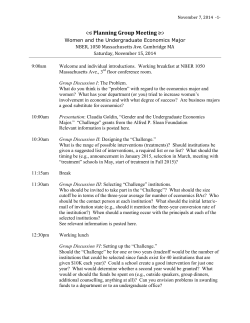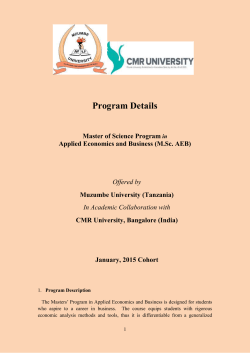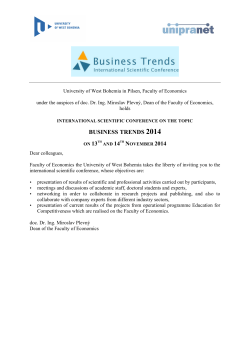
OPINION - Wall Street Journal
P2JW014000-0-A01300-1--------XA CMYK Composite CL,CN,CX,DL,DM,DX,EE,EU,FL,HO,KC,MW,NC,NE,NY,PH,PN,RM,SA,SC,SL,SW,TU,WB,WE BG,BM,BP,CC,CH,CK,CP,CT,DN,DR,FW,HL,HW,KS,LA,LG,LK,MI,ML,NM,PA,PI,PV,TD,TS,UT,WO THE WALL STREET JOURNAL. Wednesday, January 14, 2015 | A13 OPINION G eneral Motors chief Mary Barra says the company’s new electric car, the Chevy Bolt, will cost around $30,000 and get 200 miles per charge. One thing she didn’t say it would be is profitable, even considering the $7,500 that federal taxpayers will presumably contribute to each buyer. An electric car aimed at the middle class at a time when, in inflation-adterms, BUSINESS justed gasoline is sellWORLD ing near its allBy Holman W. time low, might Jenkins, Jr. seem the definition of wrongheaded. Relying on continued taxpayer subsidies to electric car buyers now that Republicans are in control of Congress might also seem a tad risky. But maybe gasoline prices will go back up. Maybe various proposals for an increased gasoline tax or carbon tax will steepen the price of gasoline enough to make the electric Bolt look like a good deal to cost-conscious, middle-income consumers. Or maybe something else is going on. For once, when a CEO uses the term “game-changer,” as Mrs. Barra did, perhaps the words should be credited with carrying actual meaning. The year 2017, when the Bolt supposedly rolls out, will also be the year of the much-anticipated midterm review of the Obama fuel-economy mandates. Let us review why a review is necessary. In the early years of the mandate Mr. Obama first announced in 2011, the rules have been tilted to protect the Domestic Three’s truck and SUV business, even at the cost of irate private emails from Toyota and A Chevy Bolt at Detroit’s 2015 North American International Auto Show. public denunciations from German car makers. In the early years, the rules have also been designed to encourage car makers to fulfill Mr. Obama’s throwaway prediction of a million electric vehicles on the road by 2015 by overegging the mileage credits for electric cars in order to help offset Detroit’s low-mileage trucks and SUVs. Its electric Chevy Bolt is about Washington games, not about making money or saving the planet. But after 2017 the full wallop of the Obama mandate kicks in. As detailed by a congressional investigation, the Obama target of 54.5 miles per gallon was not the product of science and engineering, which tell us that nearly all post-2025 cars would have to be hybrids roughly the size of a Fiat 500. Arguably the 2025 goal was never meant to be taken seriously at all. It was simply the product of the White House PR shop’s hunt for an impressive-sounding headline number. As a concession to the auto makers, and to sanity, the administration also included a statutory review to take effect just after Mr. Obama leaves office, whereupon he can be seen criticizing his successor for backsliding on the earth-saving measures Mr. Obama put into effect. As he must, Ford Chief Executive Mark Fields continues to pay lip service to meeting the 2025 target—though sometime well after 2025. “I expect we’re going to have a very robust midterm review. . . . It’s a great opportunity to talk about the feasibility and the time frame to meet those requirements,” he recently told the press. Ms. Barra put her own chip on the table in the form of the promised Chevy Bolt, which is supposed to make the federal climb-down easier. See, Detroit received the message and no longer needs a BOOKSHELF | By Roger Lowenstein History Repeating federal boot up its backside to pursue zero-emission vehicles. Though the car industry daily works to reduce its cycle time, it still takes years to bring a new vehicle into production. Deeply crazy and obviously undesirable, then, is afflicting such a high-investment industry with so much regulatory uncertainty about the fuel-mileage targets it’s supposed to begin meeting just two years hence. Which may explain another mystery. Sen. Bob Corker, usually a favorite of conservatives and hardheaded business types, is finding invective rained on his head for putting his name to a bill that would hike the federal gasoline tax. Mr. Corker represents Tennessee, which is rapidly emerging as America’s premier car-building state, with GM, VW and Nissan churning out vehicles locally. He cites the need to fund the highway trust fund, but Mr. Corker’s modest, 12-cent hike in the federal gas tax would also be an efficient way to encourage Americans to use less gas (if that really must be our goal). At this point, for any given gasoline-consumption target, it certainly would be far more efficient than continuing to inflict on car makers an increasingly convoluted, costly and politicized duty to build cars the public doesn’t want and that can only be sold at a giant loss. Mr. Corker’s bill also stipulates that any gas tax proceeds would be used to offset other taxes, but even so his bill likely won’t be going anywhere. Still, it’s another chip on the table in the game the auto industry and federal regulators and politicians will be playing over the all-important midterm review of the fuel-mileage rules. Hall of Mirrors By Barry Eichengreen (Oxford, 512 pages, $29.95) T here are two broad schools of economic history. One contends that people learn nothing and are doomed to repeat the past; the other that, with each successive crisis, understanding improves and the worst of the past’s mistakes can be avoided. Barry Eichengreen tests the latter proposition in “Hall of Mirrors,” a painstaking effort to compare the recent Great Recession with the Great Depression of the 1930s. Among much else, Mr. Eichengreen, an economist and political scientist at the University of California, Berkeley, sets out to answer a question that has been lurking in the shadows ever since 2008: Did the officials entrusted with responding to the economic crisis learn, and apply, the right lessons from the Depression? His short answer would be yes—in general, policies did improve. His more drawn-out response, which supplies the leitmotif of the book, is that contemporary policy makers did not sufficiently grasp the parallels between then and now. They could have done better. Why did such lapses occur even when Ben Bernanke, a student of the Depression, was running the Fed? Mr. Eichengreen notes that Mr. Bernanke and other officials were well aware of Milton Friedman’s diagnosis of the Depression, which focused on the shocks to the banking system—bank runs and bank failures. But they interpreted Friedman too literally. By the early 2000s, the problem of retail bank runs had been solved, thanks to the 1930s innovation of deposit insurance. Regulators thus relaxed their gaze, Mr. Eichengreen argues. They failed to see that risks were accumulating in the “shadow banking” system. Lehman Brothers and other firms experienced “runs”; the runs just didn’t consist of depositors lining up on the sidewalk. Rather, wholesale lenders pulled their loans, and regulators were unprepared for the disastrous effects. Mr. Eichengreen is even tougher on officials in Europe—not surprisingly, given the extent to which its problems have lingered. He contends that the Europeans’ biggest mistake was creating the euro in the absence of political unity. The historical parallel dates to the 1920s, when various countries on the gold standard could not devalue their currencies to dig out of hard times. This predicament was repeated in recent years, notably in Greece, by a “blind faith” in the euro, an even tighter-fitting monetary straitjacket. Europe further ignored the lessons of the Depression by flirting with austerity, resulting in serial recession and, recently, deflation. Of course, the European “obsession” with price stability cited by Mr. Eichengreen is a response to a different episode, the German hyperinflation of the early 1920s. The problem is that history offers up a lot of lessons, some of them contradictory. A Fight Obama Needs to Have With Democrats his year may be the most consequential one for trade agreements in a generation. It is all but certain to be the most combative—although America’s top negotiator is optimistic about the outcome. Unless the negotiations unexpectedly run off the rails, a draft Trans-Pacific Partnership agreement should be on the table for congressional consideration by Labor Day. Well before that, the House and Senate POLITICS will debate the & IDEAS reauthorization of By William the Export-Import A. Galston Bank, which has staunch friends and ardent foes in both parties. Later this year, attention is likely to shift to negotiations for a new Transatlantic Trade and Investment Partnership between the United States and the European Union. Preceding all of these will be trade-promotion authority (TPA), popularly known as “fast track,” which would allow the president to bring completed treaties to Congress for up-or-down votes, without amendments. In last year’s State of the Union address, President Obama asked Congress to approve TPA. Less than 24 hours later, then-Senate Majority Leader Harry Reid told him to forget about it. The president is likely to renew his call for TPA this year. The battle-lines are already forming. Last week Rep. Rosa tative Michael Froman is undaunted. He has conducted the TPP negotiations, he insists to me in an interview, with the lessons of the past, including the 1994 North American Free Trade Agreement, firmly in mind. In fact, he says, “This is the renegotiation of Nafta that Obama talked about as a candidate in 2008,” a process that will produce The president must work hard for the ‘fast track’ authority he needs to make vital trade deals. breakthroughs in areas of concern such as labor rights and environmental protection. He predicts that TPP will be the “most progressive trade agreement in history.” Whether this will be enough to mollify his Democratic critics remains to be seen. Mr. Froman also expresses confidence that he could conclude a draft TPP treaty with our trade partners. The reason: “Everyone is motivated to get it done.” Explaining their shared determination, he underscored the significance of Japan’s decision to participate in the negotiating process: “By opening Japan’s market, everyone will benefit.” Trade experts and veterans of past negotiations believe that attaining this goal requires tradepromotion authority—the sooner the better. Without TPA, they say, our negotiating partners would be reluctant to put their best and final offers on the table. One former government official told me that Japanese Prime Minister Shinzō Abe had made this link clear in a private conversation. A draft TPP that failed to crack open Japan’s agricultural market would disappoint many U.S. lawmakers and weaken support for the agreement. Everyone with whom I have talked stresses how vital TPA is to a manageable legislative process. Without a closed rule that prohibits amendments in the House and its functional equivalent in the Senate, which is what TPA amounts to, the draft would be exposed to hundreds of special-interest amendments. It is hard to believe that the House and Senate would be as likely to endorse an up-or-down vote after the draft TPP is unveiled than they are right now. Amendments would force U.S. representatives back to the bargaining table. Republican leaders have made clear that although they will have to provide the bulk of the votes for trade-promotion authority, they are unwilling to go it alone. If President Obama really wants the authority, he will have to fight for it, not just ask for it. That would mean going against the grain of his own party, which he has been reluctant to do throughout his presidency. But not doing so could turn his vaunted “pivot to Asia” into a hollow phrase. In the 1920s, electrification spurred a faith in rising productivity, fooling regulators. The same thing happened with the Web. I ’ve been teaching economics for 25 years, and yet I’ve routinely missed a perfect opportunity to explain how markets fail to deliver efficient solutions. It isn’t just me. During our first day of class in introductory economics, thousands of economics professors begin with a key lesson: how to make better decisions by carefully weighing benefits and costs. Yet we professors are shockingly blind about what our We economics professors are missing a chance to teach a lesson about the unchecked rise of prices. students pay for the textbooks from which we teach these valuable lessons. Even on Amazon, the average price of a new copy of one of the best-selling economics textbooks, “Principles of Economics” by Greg Mankiw, can be more than $250 (and retail for a hardcover edition is about $360). Think about it: For a student working at minimum wage, it would take him about 35 hours of work after taxes to afford this book. Not to pick on Mr. Mankiw, since he has written a fine book, but $250 for a new textbook? Really? In 1982 I took principles of economics for the first time and I believe I paid about $20 for a wonderful textbook by Richard Lipsey and Peter Steiner, “Economics.” Minimum wage was $3.35 then so it took about six hours of work for me to pay for the book, which I did with cash earned over the summer. (The textbooks haven’t changed all that much, by the way.) So what is going on? Since 1985, prices of all consumer goods have about doubled, but textbook prices have risen sixfold, according to the Bureau of Labor Statistics. The reason is such an interesting one that it’s surprising it doesn’t find its way into the first chapter of every economics textbook. The cardinal lesson is that prices rise unchecked if the people who order the goods aren’t paying the prices. Publishers routinely hide the suggested retail prices of their textbooks from the book cover and most of us never bother to ask what they cost. After all, we’re not paying for them, right? Instead, we’re swayed by the publisher offering us free examination copies, PowerPoints, lecture notes, quiz generators and so forth. Instead of engaging in costbenefit analysis, we only pay attention to the benefits to us Getty Images The $250 Econ 101 Textbook Composite By Craig Richardson DeLauro convened a press conference to declare that “fast track would be yet another insult to the American worker. It will not happen. We are not going to do it.” If history is any guide, Rep. DeLauro is speaking for the vast majority of House Democrats. In 2002, the last time TPA was authorized, it squeaked through the House 215 to 212, with only 25 Democrats voting in the affirmative. This was more than a Democratic declaration of no confidence in the trade priorities of a Republican president. In 1998, during the last of Bill Clinton’s failed attempts to obtain TPA, only 29 Democrats supported him. Although the Senate is typically more favorable to trade treaties than the House, the president’s prospects among Senate Democrats are at best uncertain. In 2002 only 21 Senate Democrats out of 50 supported TPA, and of those 21 only six remain in the Senate. In a speech last week to the AFL-CIO, Sen. Elizabeth Warren excoriated “trade pacts and tax deals that let subsidized manufacturers around the globe sell here in America while good American jobs get shipped overseas.” These pacts, she declared, were among the choices in Washington “that have left America’s middle class in a deep hole.” If the past is any guide, Sen. Warren is also speaking for most of her Democratic colleagues. United States Trade Represen- before ordering the outrageously expensive books that we ask our students to pay for. There’s more to this story. During the past 30 years, there has been an explosion of student-loan debt. Students rarely pay for books out of pocket and instead roll it into their financial-aid package. So a $250 textbook is now being paid back over decades. It’s a bit like the prospective car owner who pays $400 for optional floor mats when it only adds a few dollars to her monthly payment, yet would never pay cash out of pocket for the same mats. The easy access to financial aid has meant there is no natural binding mechanism on price increases, since the pain of rapidly rising prices is scarcely felt by years of student-loan payments. So here is the $250 economics textbook, a creature of government-subsidized student loans, professors who pay no attention to prices, and students who strive to push the costs down the road. It seems like a natural end of chapter one question, doesn’t it? Mr. Richardson is a professor of economics at Winston-Salem State University in North Carolina. As for modern regulators, especially in the U.S., Mr. Eichengreen gives them a mostly passing grade once the crisis hit. For him, the signal lesson of the 1930s is that when private markets implode, government must step in forcefully until some semblance of a normal economy returns. Thus he applauds governments here and elsewhere for ramping up deficit spending and central banks for flooding markets with liquidity. He thinks that more could have been done, but the point is that, in the 1930s, governments were too cautious. This time, Mr. Eichengreen writes of policy makers, “their decisions were powerfully informed by received wisdom about the mistakes of their predecessors.” It is remarkable how similar the periods were. A credit boom and a real-estate bubble were as much features of the 1920s as of the mid-2000s. In each period, new technology (earlier, electrification; recently, the Internet) spurred a faith in rising productivity and in a new era of stability, fooling regulators and encouraging permissiveness. There were also similarities once the bubbles burst. The Reconstruction Finance Corp., created by Herbert Hoover, was stymied because it lacked authority to inject capital into insolvent banks. Similar restraints discouraged federal officials from saving Lehman. Once Franklin Roosevelt succeeded Hoover, he closed the banks and announced a plan to reopen the “good” banks. Although the New Dealers hardly knew which banks were sound, the display of official wizardry boosted public confidence. The Obama administration pulled a similar trick with its “stress tests” at the nadir of the mortgage crisis. But the periods also diverged in many ways. Europe ditched the gold standard in the 1920s and ’30s, but, so far, it has clung to the euro. And the world didn’t experience anything close to a global depression during the recent crisis. Peak to trough, global GDP fell 15%, world-wide, from 1929 to 1932; it fell less than 1% from 2008 to 2009. It would have been good, then, for Mr. Eichengreen to have emphasized the limitations of history as well as its uses. Instead, his treatment goes overboard by suggesting that the periods were carbon copies in the making. He laments that regulators did “just enough”—and not more— to avoid “another Great Depression.” Their partial success, he says, undercut more substantial reforms of the sort that were enacted under the New Deal. Such an analysis implies—and Mr. Eichengreen repeatedly suggests—that without the cures prescribed by regulators in 2008, the Great Depression would have returned. But history is not so formulaic. Nor is there reason to think that reforms post-2008 should mirror those of the 1930s. The test of recent changes in policy should be whether, for instance, mortgage finance has been made more sound, not whether the same percentage of mortgage holders in the 2000s received government refinancing as in the 1930s. Mr. Eichengreen seeks both to contrast the eras and to narrate them pulse for pulse. He gives us the story not only of Charles Ponzi and the Florida land boom in the 1920s but also, in our own time, the sagas of Countrywide’s Angelo Mozilo and of Greece. “Hall of Mirrors” is dense with detail, survey-like in breadth. Although the detail is often striking, the avalanche of information somewhat obscures the book’s purpose. When, however, Mr. Eichengreen mines his material for lessons learned and lost, “Hall of Mirrors” becomes a worthy, and distinctive, addition to the literature on the crash. Mr. Lowenstein is the author of “The End of Wall Street.” P2JW014000-0-A01300-1--------XA T Zuma Press What’s GM Thinking? MAGENTA BLACK CYAN YELLOW
© Copyright 2025









